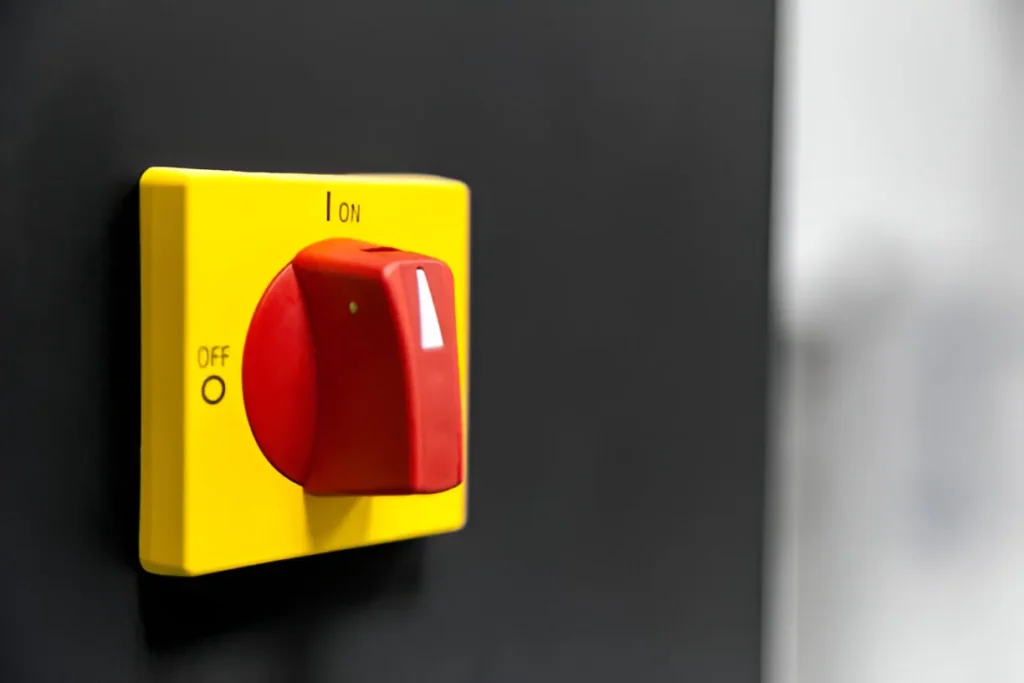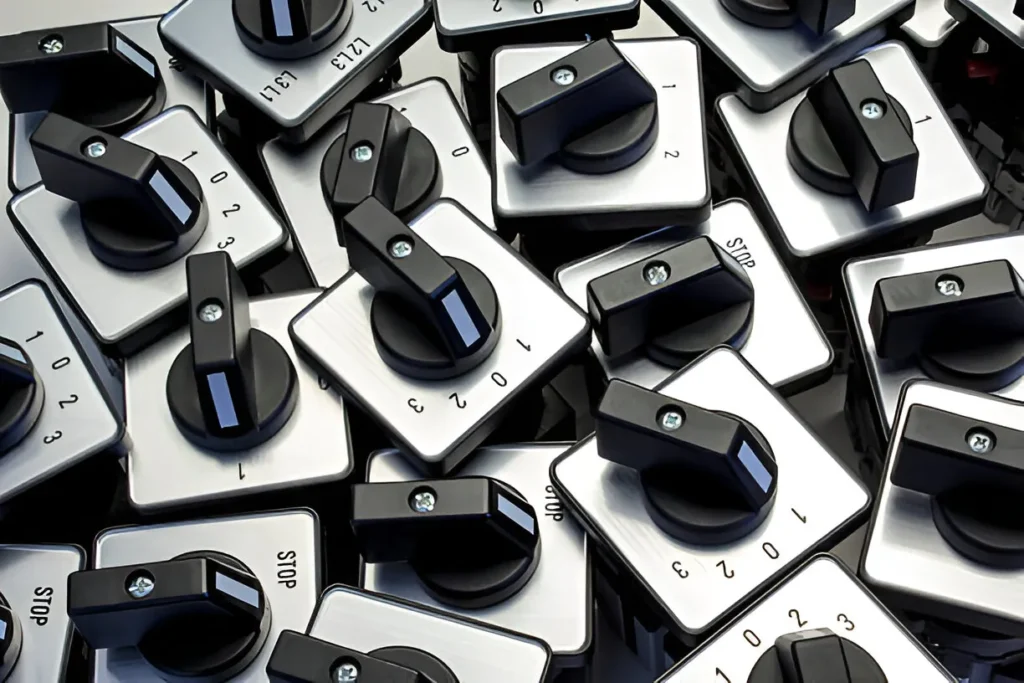Rotary cam switches are marvels of simplicity tackling complex tasks. At their heart lies the cam – a pivotal component that rotates or slides linearly. This unassuming piece orchestrates a mechanical ballet, pushing and pulling switch elements to control electrical flow with precision.
The beauty of these switches lies in their direct mechanical action. No fancy electronics, just pure, reliable movement translating into electrical control. This straightforward approach yields unparalleled accuracy and dependability.
But don’t let their simplicity fool you. These switches are chameleons of the electrical world, adapting to a dizzying array of applications. From basic on/off functions to intricate multi-circuit choreography, rotary cam switches rise to the occasion. Their versatility makes them indispensable across diverse electrical landscapes.
In the grand scheme of electrical systems, these switches are the unsung heroes. They ensure smooth operations, maintain efficiency, and provide the flexibility needed in our ever-evolving technological world. Whether you’re running a factory floor or managing a complex power grid, rotary cam switches are the silent guardians keeping everything in check.
The Role of Rotar Cam Switches in Electrical Systems
Rotary cam switches play a critical role in controlling electrical systems. Their innovative design and functionality make them essential for regulating the flow of electricity to and from machines and equipment. With a simple turn of the switch, operators can effortlessly power devices on or off, maintaining complete control over operations.
- Circuit Switching: One of the standout features of rotary cam switches is their ability to switch between different circuits without requiring multiple switches. This is particularly beneficial in systems that rely on alternate power sources or need to frequently switch between operational modes.
- Machine Function Adjustment: These switches go beyond basic on/off functionality. They allow operators to modify machine operations, such as altering speeds, initiating different phases, or activating specific functions. This is achieved through the precise positioning of the cam, offering a high degree of control.
- Precision and Accuracy: The engineering behind rotary cam switches ensures exact adjustments to electrical configurations. This level of precision is vital in applications where specific power levels or circuit paths are necessary for optimal performance.
- Wide-Ranging Applications: From intricate machinery and control panels to simpler devices, rotary cam switches are highly versatile. Their adaptability makes them a cornerstone of modern electrical engineering, seamlessly integrating into diverse settings.


Advantages of Rotary Cam Switches
Rotary cam switches stand out as essential components across industries due to their unique blend of resilience and adaptability. Below are the standout features that elevate their utility:
Long-Term Reliability
Engineered for extended service life, these switches withstand intense operational demands through resilient construction. Their design prioritizes stability in harsh industrial environments—where consistent performance matters as much as endurance. Key strengths include:
- Resistance to mechanical degradation, maintaining precision over repeated cycles.
- Capacity to manage elevated power loads, ideal for heavy-duty equipment.
- Minimal maintenance needs due to wear-resistant materials.
Adaptable Operation
Rotary cam switches excel in versatility, offering tailored solutions for diverse control scenarios. Their modular architecture supports dynamic adjustments, enabling users to:
- Configure settings for specialized system demands.
- Consolidate multi-step operations into a single interface, streamlining workflows.
- Modify layouts by adding, removing, or repositioning components for evolving needs.
This flexibility extends to physical dimensions, with compact and extended models fitting spatial constraints without sacrificing functionality.
Optimized Performance in Advanced Systems
In intricate electrical networks, rotary cam switches bridge durability and precision. Their hybrid design proves invaluable for:
- Critical infrastructure requiring fail-safe switching under fluctuating conditions.
- Seamless transitions between operational modes, reducing downtime risks.
- Integration with automated systems, where consistent signal routing ensures safety protocols.
By combining ruggedness with customizable control pathways, these switches enhance both efficiency and system longevity, cementing their role in modern engineering solutions.
Types of Rotary Cam Switches and Their Applications
Rotary cam switches come in diverse designs, each tailored to address specific electrical control challenges. Selecting the right type hinges on grasping their unique functionalities and aligning them with operational demands.
On-Off Switches
These switches serve a foundational role in electrical systems, acting as gatekeepers for power flow. A simple rotation connects or disconnects circuits, making them indispensable for basic control.
Common Uses:
- Residential appliances (e.g., lamps, kitchen gadgets) where straightforward operation is key.
- Small-scale machinery in workshops, enabling quick shutdowns for safety.
- Portable devices requiring reliable, no-frills power management.
Changeover Switches
Stepping beyond basic functionality, these switches toggle between two circuits or power sources. This dual-path capability ensures continuity in critical systems.
Typical Scenarios:
- Backup power setups in hospitals, ensuring life-support systems stay active during outages.
- Industrial production lines, where switching machinery modes avoids costly downtime.
- Telecom infrastructure, maintaining signal routing during maintenance or failures.
Multi-Position Switches
Designed for intricate control, these switches manage multiple circuits simultaneously. A single dial can orchestrate several operations, reducing clutter in complex setups.
Ideal Applications:
- Centralized command hubs for HVAC systems, adjusting airflow, temperature, and humidity.
- Automotive diagnostic tools, cycling through test parameters like voltage and RPM.
- Assembly line control panels, synchronizing conveyors, actuators, and safety interlocks.
Step Switches
Precision defines these switches. They enable gradated adjustments, moving through predefined settings to fine-tune outputs like speed or torque.
Key Deployments:
- Conveyor belt speed regulation in logistics warehouses, balancing load handling and energy use.
- Lab equipment calibration, where incremental power adjustments ensure accuracy.
- Automated packaging systems, sequencing sealing, labeling, and sorting phases.
By matching switch capabilities to system needs—whether basic power control or multi-layered automation—users optimize performance while prioritizing operational safety. The right rotary cam switch not only streamlines workflows but also extends equipment lifespan through durable, purpose-driven design.


Key Features to Consider When Choosing a Rotary Cam Switch
When choosing a rotary cam switch, several crucial factors must be considered to ensure optimal performance and safety:
Electrical Specifications
The switch’s capacity to handle electrical loads safely is paramount:
- Current Rating: Select a switch that meets or exceeds your system’s current requirements to prevent overheating and fire risks.
- Voltage Rating: Ensure the switch can handle the maximum voltage level of your application to maintain operational safety.
Functional Design
The switch’s versatility is determined by its structural design:
- Number of Positions: More positions offer greater control over various functions or circuits4.
- Contact Configuration: The quantity and arrangement of contacts define the switch’s control capabilities and complexity.
Functional Design
The switch’s versatility is determined by its structural design:
- Number of Positions: More positions offer greater control over various functions or circuits.
- Contact Configuration: The quantity and arrangement of contacts define the switch’s control capabilities and complexity.
Practical Considerations
Ease of use and installation are important for efficient integration:
- Installation Simplicity: Choose switches designed for straightforward setup to reduce installation time and errors.
- User-Friendly Operation: Ensure the switch is easy to operate to minimize the risk of incorrect use and potential system failures.
Applications of Rotary Cam Switches in Industry
Manufacturing and Automation
Rotary cam switches are essential in manufacturing and automation, controlling a wide range of machinery from conveyor belts to complex robotic assembly lines. These switches enable seamless task performance and function switching without manual intervention, enhancing productivity and safety.
Their ability to safely isolate machinery for maintenance or emergencies minimizes accident risks. The switches’ adaptability to specific manufacturing needs, such as dust and vibration resistance, makes them indispensable in automation.
Energy and Power Distribution
In the energy sector, rotary cam switches play a crucial role in power distribution systems. They ensure stable energy supply by controlling generators, managing load distribution, and facilitating transitions between main and backup power sources.
This is particularly vital for critical facilities like hospitals and data centers, where power reliability is essential. Rotary cam switches help maintain essential services and prevent disruptions during power outages.
Marine and Aerospace
Rotary cam switches are vital in marine and aerospace industries, where demanding conditions require precise and durable components. These switches provide reliable control over navigation, propulsion, and communication systems in ships and aircraft.
Their robust design allows them to withstand harsh environments, including high humidity, saltwater exposure, and extreme temperatures. This reliability is crucial in scenarios where failures could have critical consequences, emphasizing the importance of rotary cam switches in ensuring safety and efficiency in marine and aerospace operations.
Maintenance and Safety Tips for Rotary Cam Switches
Regular Inspection and Cleaning
Maintaining rotary cam switches is crucial for their longevity and reliability. Conduct periodic inspections to spot wear, corrosion, or damage early on. Keep contacts clean and debris-free using manufacturer-recommended solutions. For copper contacts, use KS-19578 L1 trichloroethane to remove dirt and old lubricant. Silver-plated contacts require flushing with the same solution using an R-8950 rubber syringe.
Wipe accessible surfaces with a soft, clean, non-lint cloth like KS-2423 or KS-14666. Aim for annual inspections and cleanings, or more frequently in demanding environments. This proactive approach prevents unexpected downtime and extends switch life.
Understanding Load Ratings
Load ratings are vital for safe and effective switch operation. They define the maximum current and voltage a switch can handle safely. Exceeding these limits can cause overheating, fires, or catastrophic failures.
Select switches with ratings that match or exceed your system’s requirements. Regularly review electrical loads to ensure they stay within safe limits. For microloads, confirm that application conditions fall within the specified current-voltage range. Consider inrush currents, especially for motor and lamp loads, when determining switch applicability.
Professional Installation and Repair
Complex electrical systems often require expert installation and repair of rotary cam switches. Professional handling ensures correct configuration and system integration, minimizing risks of malfunctions or safety hazards.
Experts can identify and rectify potential issues during installation or maintenance, guaranteeing safe and efficient switch operation. Seeking professional assistance is a wise investment in electrical system reliability and safety. It’s an essential aspect of proper rotary cam switch management.
Conclusion
Rotary cam switches stand as pillars of control across diverse industrial landscapes. From the bustling floors of manufacturing plants to the critical systems of energy distribution, these unassuming devices wield immense power. They’re the silent guardians of efficiency in aerospace and the steadfast sentinels in marine environments.
Selecting the ideal switch isn’t just a matter of picking a part; it’s a crucial decision that demands careful thought. You must weigh technical specs against the harsh realities of where your switch will live and breathe. And once installed, these switches aren’t set-and-forget components. They thrive on attention – regular check-ups and tender loving care ensure they’ll serve you well for years to come.

